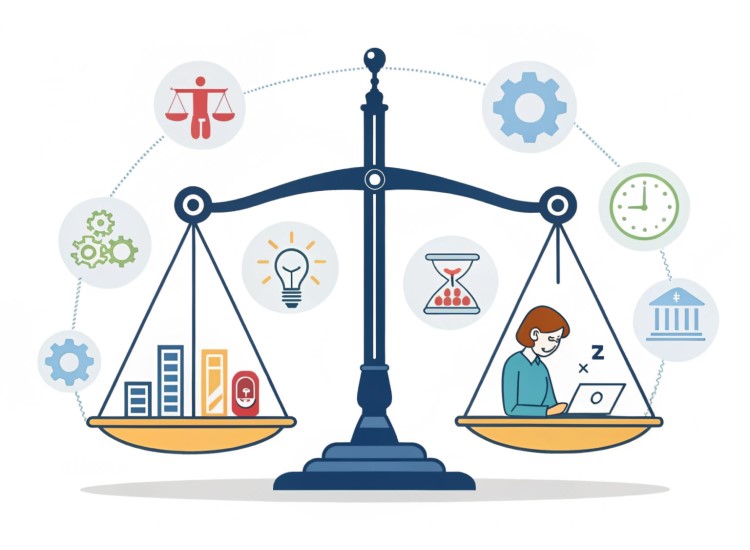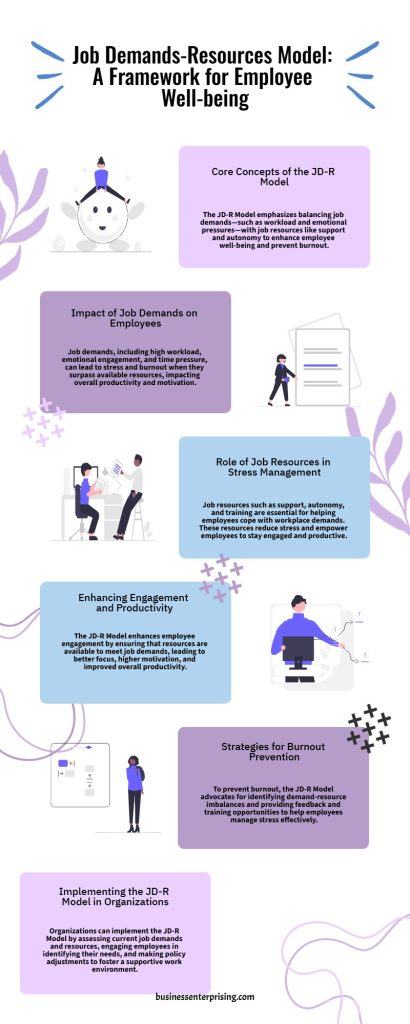
Introduction to the Job Demands-Resources (JD-R) Model: Origins and Core Concepts
The Job Demands-Resources Model, developed in the early 2000s, is a valuable framework in organizational psychology. Its main principle focuses on balancing job demands and resources to support employee well-being. Job demands include aspects like workload, deadlines, and emotional strain, which can create stress when they’re high. Resources, on the other hand, refer to supportive elements like autonomy, feedback, and team support, which help you manage demands and stay engaged.
The JD-R Model suggests that when demands outweigh resources, employees are at risk for burnout. However, when resources balance or even exceed demands, you see higher levels of motivation and engagement. This balance allows employees to work productively while staying resilient in the face of challenges. By addressing both sides, the Job Demands-Resources Model offers a practical way to improve job satisfaction and performance.
This model is widely used across industries because it adapts to different organizational structures and roles. It’s flexible, allowing you to assess specific demands and resources relevant to your team. By applying the Job Demands-Resources Model, you can create a more supportive work environment, fostering both personal and organizational growth.
Understanding Job Demands: Types and Their Impact on Employees
In the Job Demands-Resources Model, job demands are the aspects of your role that require effort and energy. Common job demands include workload, emotional demands, and time pressure. Each of these demands can impact your well-being if they consistently outweigh available resources. High workload, for example, often leads to stress when deadlines are tight or when you face multiple tasks with limited support. Over time, excessive workload can reduce motivation and lead to burnout.
Emotional demands are also significant, especially in roles involving client or customer interaction. These demands require you to manage emotions, remain positive, and handle challenging situations. Such continuous emotional engagement can feel exhausting, increasing the risk of emotional exhaustion and reducing resilience. If left unaddressed, emotional demands often contribute to burnout.
Time pressure is another key job demand, especially in fast-paced environments. Deadlines and tight schedules can increase efficiency but also raise stress levels. When time constraints are constant, they can lead to poor work-life balance, impacting health and overall job satisfaction. The Job Demands-Resources Model recognizes these demands as potential stressors, especially when they’re not balanced by adequate resources. By understanding the types of demands you face, you can find ways to better manage stress and support long-term productivity.
Exploring Job Resources: Types of Resources and Their Benefits
In the Job Demands-Resources Model, job resources play a vital role in helping employees manage workplace demands and improve their well-being. Job resources include support, autonomy, and training. Each of these resources can act as a buffer against stress, helping you stay engaged and productive. Support, whether from managers or colleagues, provides you with encouragement and assistance. When you feel supported, it’s easier to tackle challenges, and you’re more likely to feel connected to your team.
Autonomy is another critical resource in the Job Demands-Resources Model. Autonomy gives you the freedom to make decisions about how you complete your work. With autonomy, you gain a sense of control, which can reduce stress and increase motivation. When you have flexibility in your role, you’re also more likely to take ownership of your tasks, leading to greater job satisfaction.
Training is equally valuable as it equips you with the skills to perform your role effectively. Access to ongoing training allows you to develop professionally and feel confident in your work. When you have the knowledge and tools needed, you’re better prepared to meet demands, which reduces stress. Job resources like support, autonomy, and training not only help you manage demands but also promote well-being, engagement, and long-term growth.
How the JD-R Model Improves Employee Engagement and Productivity
The Job Demands-Resources Model improves employee engagement by balancing the demands of a role with available resources. When you have resources like support, autonomy, and training, you feel more equipped to handle the demands of your job. This balance reduces stress and helps you stay focused, which boosts motivation and commitment. With the right support, you’re likely to approach tasks with greater energy and enthusiasm.
Balancing demands and resources also enhances productivity. When demands are high without adequate resources, employees can feel overwhelmed, leading to burnout and reduced performance. However, when resources match or exceed demands, you’re more likely to work efficiently and manage challenges without losing momentum. In this environment, employees have what they need to succeed, allowing them to complete tasks more effectively.
Through the Job Demands-Resources Model, organizations can create a healthier work environment that values employee well-being and fosters engagement. When employees feel supported and capable, they are more invested in their work and willing to contribute to the organization’s goals. This approach benefits both employees and the organization, leading to a productive, motivated, and resilient workforce.
Preventing Burnout with the JD-R Model: Practical Applications
The Job Demands-Resources Model offers a practical way to prevent burnout by identifying and addressing risks before they escalate. When you balance job demands, like workload and time pressure, with resources such as support and training, you help employees manage stress effectively. By regularly assessing both demands and resources, organizations can detect imbalances that may lead to burnout. This proactive approach allows you to make necessary adjustments, providing employees with the tools they need to thrive.
One application of the JD-R Model is using regular feedback sessions to monitor stress levels and resource needs. During these discussions, you can identify any factors that may be causing undue pressure. For example, if employees are struggling with high emotional demands, adding support resources can help alleviate stress. This ongoing dialogue helps prevent burnout by addressing potential issues early on.
Another effective strategy is offering targeted training and development opportunities to strengthen employees’ ability to meet job demands. By enhancing skills and competencies, you equip employees with greater confidence and capability. This balanced approach promotes sustainable well-being, ensuring that employees feel supported and resilient. By applying the Job Demands-Resources Model in these ways, you create a healthier workplace where employees remain engaged and motivated, even when faced with challenging demands.
Implementing the JD-R Model in Your Organization: Practical Steps and Strategies
To implement the Job Demands-Resources Model in your organization, begin by assessing current demands and resources. Review the workload, emotional pressures, and time requirements each role involves. Identify areas where demands are high and consider if existing resources like training, support, and autonomy are sufficient. By examining these factors, you gain insights into where adjustments are needed to create a more balanced work environment.
Involve employees throughout this process to gain a clearer understanding of their daily experiences. Ask employees about the resources they need to manage their tasks effectively. Open conversations allow you to address specific challenges, as employees may highlight needs that aren’t immediately visible. By actively engaging your team, you demonstrate that their well-being is valued, which can increase motivation and job satisfaction.
Finally, adjust policies to support balance between demands and resources. Consider flexible work options, additional training opportunities, or more supportive leadership practices. These adjustments align with the principles of the Job Demands-Resources Model, creating an environment where employees feel equipped to meet demands without undue stress. As you implement these strategies, continue to monitor and adapt based on feedback, ensuring a work environment that fosters productivity, engagement, and resilience.
Conclusion
The Job Demands-Resources Model offers a practical approach to creating a balanced and engaging workplace. By understanding and managing both job demands and available resources, you promote well-being, prevent burnout, and enhance productivity. This model empowers you to adapt strategies that support employees, helping them stay motivated and resilient. As demands and resources evolve, continue assessing and adjusting to maintain a supportive environment. By applying the Job Demands-Resources Model thoughtfully, you create a workplace where both employees and the organization thrive.


